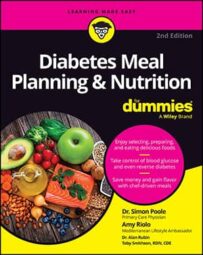Diabetes-friendly foods to keep on hand
One trick to eating healthier is keeping diabetic-friendly choices available at all times. You can fight the urge to hit the fast-food drive-through and instead whip up a convenient and healthy breakfast, lunch, dinner, or snack if you keep the right foods handy. Some healthy foods to always have on hand in your pantry include:
- Extra-virgin olive oil for healthy, unsaturated fats and polyphenols
- Frozen fruits and vegetables for healthy choices at every meal
- Herbs and spices, fresh or dried, to replace salt with intense flavors
- Whole-grain, high-fiber tortillas for sandwich-like lunches without the full amount of carbohydrates in bread
- Canned tuna (in water) to have healthy seafood available anytime — aim to eat seafood twice each week
- Unsalted almonds, walnuts, or peanuts for healthy fats
- Black beans (or your favorite beans) for healthy carbohydrate, protein, and soluble fiber. Buy no-added-salt or preservatives varieties of canned beans
- Unsweetened Greek yogurt, kefir, or other fermented dairy products. Remember that milk products include carbohydrates
- Tea, including green tea and herbal teas, for relaxation and powerful polyphenols
Managing diabetes takes more than just food
Preparation for diabetes meal planning and nutrition starts with a very minor kitchen makeover. Your kitchen should be set up for ease of food preparation, and that includes everything from measuring cups and scales to the right ingredients.
Preparing food at home more often than not simply makes diabetes management easier, so your kitchen should make food preparation convenient. Some kitchen tools you want to have handy include:
- Food scale for weighing food portions
- Steamer basket for cooking fresh vegetables to reduce nutrient loss that occurs while boiling
- A small bottle for everyday use of extra-virgin olive oil transferred from a larger container that is cheaper to purchase
- Measuring scoops for easy measuring of oats and grains
- A grater for citrus zest, fresh ginger, and other flavors that can replace salt in your food
- Salad spinner to wash and dry salad fixings
- Vegetable peeler to take the work out of prepping fresh fruits and veggies
- Sharp knives can make a huge difference in the work involved
- A carb counting book or smart phone app so you’re not guessing what your dietitian recommends
After you get your ingredients together and your meal ready for preparation, remember that the healthiest ways to cook are:
- Steaming
- Baking
- Roasting
- Grilling
- Sautéing or light frying
- Stir frying
Foods you can still enjoy when you have diabetes
Many people with diabetes think that they can’t have “fun food,” such as good breads or sweet and creamy ice cream. With a little tweaking and swapping, you can enjoy many different kinds of foods that you might have believed were off limits! Check these out:
- Ice cream: Choose no-sugar-added ice cream and count the carbohydrates. But watch out for those added ingredients like emulsifiers. Maybe substitute with frozen yogurt.
- French fries: Choose low-fat, frozen, baked fries and count the carbohydrates.
- Bread: Choose whole-grain, sourdough, and ancient grain breads when possible and count the carbohydrates.
- Fruit: Fruits are a key source of nutrients and a healthy way to satisfy your cravings for sweets. Count the carbohydrates and choose fresh fruit when possible or canned fruit packed in juice, not syrup.
The one constant theme throughout this list is to count the carbohydrates. Keep carbs in mind and you can enjoy a wide variety of foods.
Heart-healthy carbohydrate choices for diabetes
A heart-healthy diet can help prevent the complications of diabetes for years to come. Part of that healthy diet is learning to manage your intake of carbohydrate foods. You can do a lot to help your body work better by adopting and sticking to a heart-healthy diet.
When it comes to diabetes, food is medicine.
Carbohydrates are found in lots of different foods. But the healthiest carbohydrate choices include whole grains, vegetables, fruits, legumes, beans, and low-fat dairy products. The following table shows a single serving of carbohydrate-containing foods, which equals 15 grams.
| Food | One 15-Gram Serving |
|---|---|
| Apple or orange | medium sized |
| Bagel | 1/2 small bagel |
| Banana | 1/2 medium |
| Bread | 1 slice |
| French fries | 10 fries |
| Honeydew melon | 1 cup |
| Hot cereal (oatmeal, grits) | 1/2 cup, cooked |
| Milk | 1 cup |
| Orange juice | 1/2 cup |
| Plain yogurt (no fruit) | 2/3 cup |
| Popcorn | 3 cups, popped |
| Pudding (sugar-free) | 1/2 cup |
| Raisins | 2 tablespoons |
| Raspberries | 1 cup |
| Rice or pasta | 1/3 cup, cooked |
| Unsweetened cereal | 1/2 cup |
| White potato | 3 ounces |

